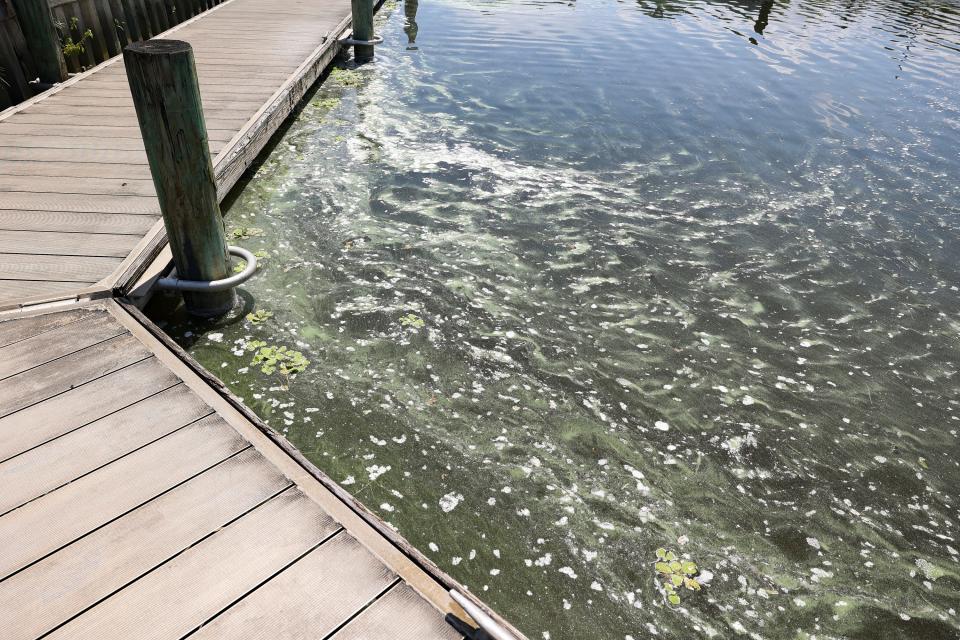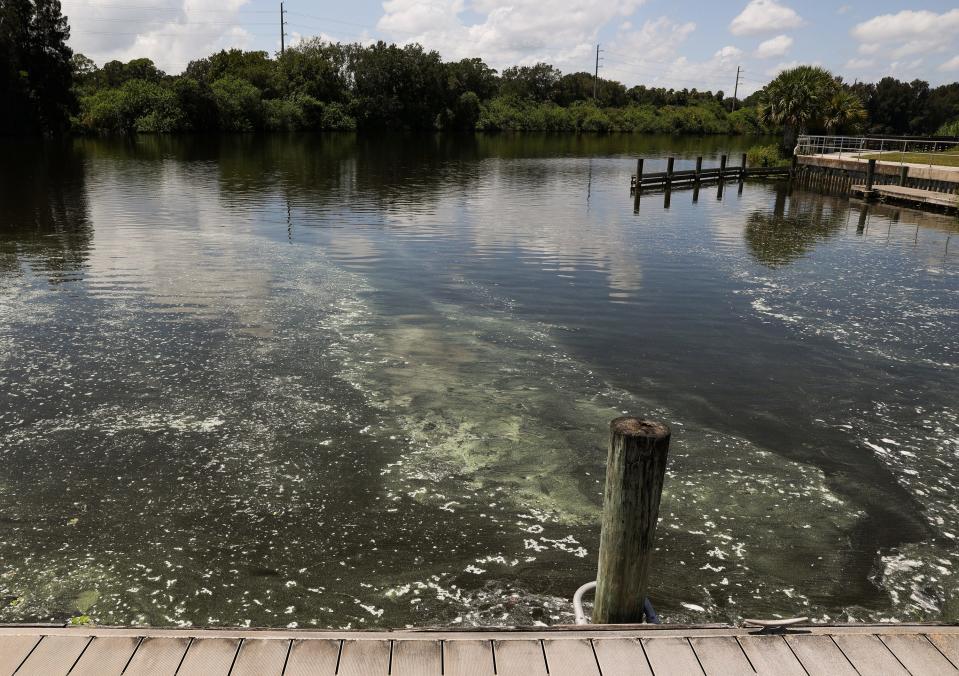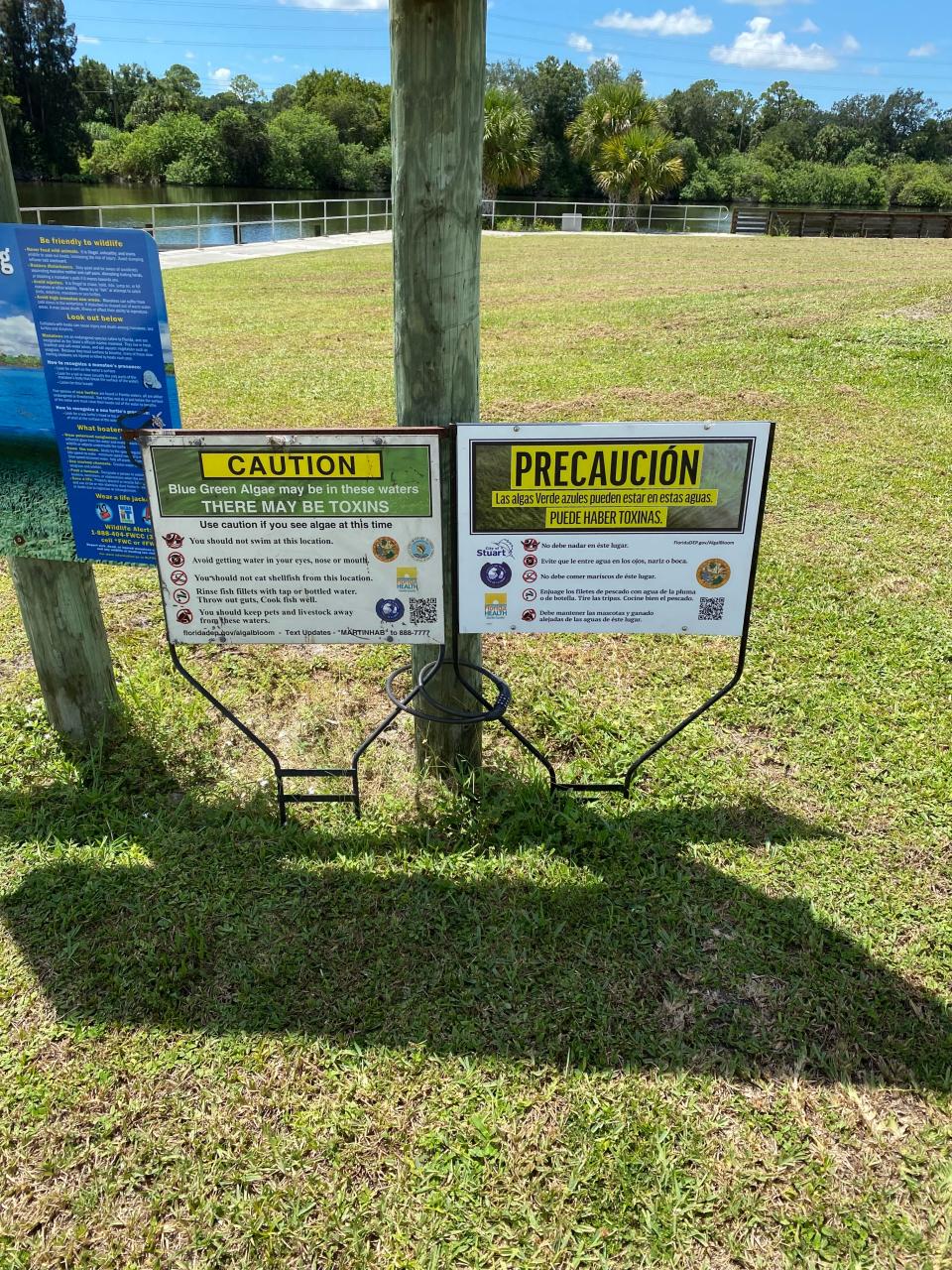Army Corps' Lake Okeechobee releases carry toxic algae to Timer Powers Park in Indiantown
Toxic algae from Lake Okeechobee is polluting the C44-Canal at the Timer Powers Park boat ramp in Indiantown, the state warned in a health alert Tuesday.
The state found 800 micrograms per liter of the microcystin toxin in the cyanobacteria, commonly called blue-green algae, according to water samples the Department of Environmental Protection took Aug. 3. That's 100 times the amount the Environmental Protection Agency considers safe for people and pets.
The Army Corps of Engineers not only opens navigational locks for boats to pass through, but it recently opened the Port Mayaca floodgates and discharged over 8.7 million gallons of toxic algae-laden Lake O water into the C-44 Canal. Then it opened the St. Lucie Lock & Dam floodgates for a few hours Saturday and released about 161 million gallons of rainfall runoff toward the St. Lucie River in Stuart, according to Lt. Col. Todd Polk.
Heavy rainfall had increased the C44-Canal to 14.5 feet, the maximum desired level, and was continuing to rise, Polk said. Ironically, the Corps had released Lake O water into the C44-Canal for 10 days — from July 25 to Aug. 1 and again on Aug. 3-4 — to increase the canal level from 12.5 feet to 14.5 feet for several reasons, Polk said:

To allow safe boat passage
To supply citrus and other farms with water to irrigate their crops
To supply drinking water to municipalities
To replenish stormwater treatment areas.
Lake Okeechobee discharges
Over 18% of Lake O was covered in a 140-square-mile toxic algae bloom Aug. 7, which was less than the day before, but satellite-obscuring clouds and algae-mixing wind could cause an underestimation of its size, according to the National Oceanic and Atmospheric Administration. The bloom first appeared Feb. 23.
The Corps currently is not releasing Lake O water into the C44-Canal or the St. Lucie Lock & Dam floodgates.

Lake O discharges have been on and off all year:
Jan. 22: Army Corps started discharging 320 million gallons of Lake O water per day
Feb. 22: DOH issued a health alert because a water sample tested positive for toxic algae
Feb. 28: Army Corps suspended discharges and South Florida Water Management District used a peroxide-based algicide to reduce the toxin's concentration
March 2: Army Corps resumed discharges at the same rate of 320 million gallons per day
March 5: Army Corps suspended discharges for a second time after Port Mayaca Lock & Dam workers observed toxic algae in the water
March 10: Army Corps resumed discharges at an increased rate of 323 million gallons per day.
April 15: Army Corps stopped discharges because of toxic algae
Aug. 5: Army Corps discharged 161 million gallons.

People should expect the effects of toxic algae, which can cause a runny nose, watery eyes and trouble breathing. Long-term exposure has been linked to liver disease and suspected of causing neurological ailments such as Parkinson's, Alzheimer's and amyotrophic lateral sclerosis, commonly called ALS or Lou Gehrig's disease.
The DOH-Martin office put up warning signs at Timer Powers Park Monday, a spokesperson said, and advised people to take these precautions:
Do not drink, swim, wade, use personal watercraft, water ski or boat in waters where there is a visible bloom.
Wash your skin and clothing with soap and water if you have contact with algae or discolored or smelly water.
Keep pets away from the area. Waters where there are algae blooms are not safe for animals. Pets and livestock should have a different source of water when algae blooms are present.
Do not cook or clean dishes with water contaminated by algae blooms. Boiling the water will not eliminate the toxins.
Eating fillets from healthy fish caught in freshwater lakes experiencing blooms is safe. Rinse fish fillets with tap or bottled water, throw out the guts and cook fish well.
Do not eat shellfish in waters with algae blooms.
More information is available on the Florida Department of Health website.
What to do if you see an algal bloom?
Report it to DEP online or via its toll-free hotline at 855-305-3903.
Report fish kills to the Florida Fish and Wildlife Research Institute at 800-636-0511.
Report symptoms from exposure to a harmful algal bloom or any aquatic toxin to the Florida Poison Information Center at 800-222-1222.
Contact your veterinarian if you believe your pet has become ill after consuming or having contact with water containing blue-green algae.
If you have other health questions or concerns about blue-green algae blooms, call the Florida Department of Health in Martin County at 772-221-4000.
Katie Delk is TCPalm's environment reporter. Contact her at katie.delk@tcpalm.com or 772-408-5301. Check for updates @katie_delk.
This article originally appeared on Treasure Coast Newspapers: Army Corps' Lake Okeechobee releases carry toxic algae to Indiantown

